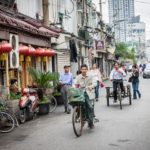Posts in the 'Road Safety' category
At a training session at the World Bank in Washington, DC two years ago, Dr. Kavi Bhalla from the Johns Hopkins Bloomberg School of Public Health asked attendees to look down at the palms of their hands. The meeting included ...

Bangalore is India’s third most populous city and is among the top 100 cities that contribute to the global economy. 75 percent of Bengaluru’s income is from the service sector, with over ₹ 500 billion (approximately US $7.6 billion) from ...

The famed American landscape architect and Central Park designer Fredrick Law Olmsted said that parks are the “lungs of the city.” However, many cities around the world—from growing Addis Ababa to sprawling Mumbai and dense Sao Paulo—currently lack adequate public ...

The benefits of cycling—both for cities and people—are well known. For individuals, cycling can be an efficient, safe and cheap form of mobility as well as a good source of physical activity, helping to reduce obesity and other health risks. ...

Physical inactivity is one of the ten leading risk factors for death worldwide. Approximately 5.3 million people die prematurely every year due to cardiovascular diseases, breast and colon cancer and diabetes and other illnesses associated with sedentary lifestyles. According to The ...

Major changes in thinking never happen easily. Projects that change established structures and routines typically encounter significant resistance along the way. Changing entrenched thinking, therefore, often requires finding ways to demonstrate the positive impacts of change. Paulista Aberta is one ...

More than 15 million people in the UK live in areas that have already adopted or are currently adopting speed limits. This data comes from the 20’s Plenty for Us, an organization in the UK dedicated to lowering speed limits ...

From air pollution to intense traffic congestion, China faces an array of environmental and resource challenges, many of which are a result of its urbanization and development over the past few decades. In Beijing—as across most of the country—concerns over ...

As part of Bogotá’s 16th annual car-free day on February 4, 2016 the city reaffirmed its commitment to safe cycling by converting one of the four lanes on Carrera 11—a major road—into a two-way bike lane. The road has included ...

Transcending borders, bicycles have emerged as an essential transport option for citizens—and they play a significant role in making cities more sustainable. However, concerns about bike theft have held back both public bikeshare schemes and discouraged individual cyclists. As virtually ...

A city cannot be inclusive without ensuring women’s safety in public transport. Women often remain a vulnerable part of the transit users, as many face violence, verbal harassment, physical abuse and discriminatory graffiti messages in stations. For example a third ...

For the first time in history, Beijing’s government issued a “red alert” for smog, shutting down the city for three days. Announced on December 7, the alert took place while COP21 was in full swing at Paris, where China, the ...

Globally, 1.3 million people die each year in road traffic crashes. India, with only 2 percent of the global motor vehicle population, accounts for more than 10 percent of those fatalities. Further, in 2014 about 141,000 people lost their lives ...

India has the highest number of traffic-crash deaths in the world. Of the 140,000 fatalities that occur annually, more than 40 percent take place in urban areas. A large percentage of these are pedestrians and bicyclists, who typically comprise more ...

Cycling in cities, especially in areas you’re unfamiliar with, can be a stressful experience. One of the most anxiety-inducing aspects of cycling is ambiguity; it can be difficult to tell what areas of the cities have designed bike lanes, where ...

Page 6 of 34« First...567...1020...Last »






















